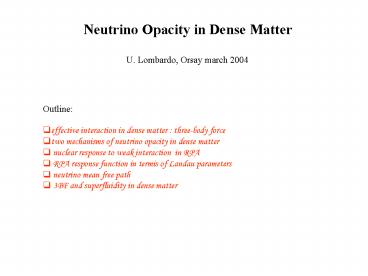Neutrino Opacity in Dense Matter - PowerPoint PPT Presentation
1 / 27
Title:
Neutrino Opacity in Dense Matter
Description:
two mechanisms of neutrino opacity in dense matter. nuclear ... 2) Fujita-Miyazawa 3BF (with isobar,non isobar,...excitations) Nucleonic resonance N(1440) ... – PowerPoint PPT presentation
Number of Views:31
Avg rating:3.0/5.0
Title: Neutrino Opacity in Dense Matter
1
Neutrino Opacity in Dense Matter
U. Lombardo, Orsay march 2004
- Outline
- effective interaction in dense matter
three-body force - two mechanisms of neutrino opacity in dense
matter - nuclear response to weak interaction in RPA
- RPA response function in termis of Landau
parameters - neutrino mean free path
- 3BF and superfluidity in dense matter
2
- One of the main challanges of nuclear
astrophysics is to try to trace - the (time) evolution of the neutron star
cooling. - Starting from its birth the main steps are
assumed - to be
- 0 birth from supernova
explosion - 20s neutrino trapping gt rapid
deleptonization - 10-102 yrs thermal relaxation stage (?
? ) - 105-106yrs neutrino cooling stage L?gtgtL?
() - T gt 106yrs photon cooling stage L? gtgtL?
- Recent exhaustive reviews are
- gtPrakash,Lattimer,Pons,Steiner and Reddy
- Lecture Notes in Physics, Springer Verlag
(2001), - gtYakovlev Pethick
- astro-ph/0402143 (2004)
3
Cooling curves
Superfluid
Non superfluid
Yakovlev et al
4
- dense-matter behaviour is mainly ruled by
three-body forces - due to
- NN virtual excitations via heavy meson fields
- (derived by
GE Brown et al from DB) - 2) Fujita-Miyazawa 3BF (with isobar,non
isobar,...excitations) - Nucleonic resonance N(1440)
- (introduced
by Grange,Mathiot,...)
5
NN virtual excitations
total
6
Fujita Miyazawa (1957)
?,?
?
?,?
......
?,?
?,?
N N N
N N N
also N(1440) implicitly included
Chiral perturbation theory
Tucson-Melbourne
?,?
?,?
Lutz,Friman,Appel PLB 474 (2000) Kaiser,Fritsch,We
ise (2001)
Off-shell extension of N? scattering T
2?-3BF settled on QCD symmetry properties,but
expected negligible at high density?
7
virtual nucleon excitations
N
N(1440)
from Tp750MeV pp?pp?? - (Patzold et al, PRC 67
(2003) decay widths
Grange,Lejeune,Martzolff,Mathiot PRC (1989)
8
VV2V3
9
- Along with the neutrino prodution rate a
- main property which determines cooling rate is
- the neutrino opacity
- (heat capacity,thermal conductivity)
- Recent contributions
- .........
- Burrow,Sawyer, PR C58 (1998)
- Reddy,Prakhash,Lattimer,Pons, PR C59 (1999)
- Bombaci, Margueron, Vidana, PR C68 (2004)
- Shen, Lombardo, Van Giai, PR C68 (2004)
10
weak interaction coupling
dynamical structure fncts
lepton tensor (WS theory)
W
? absorption
11
Dynamical structure function
- Free Fermi gas no correlations except for Pauli
blocking - Mean field model short range pp correlations
incorporated - Fermi liquid long range ph correlations
12
RPA response function (Bethe-Salpeter Eq.)
scattering
absorption
13
(No Transcript)
14
Residual interaction in BHF
15
Neutrino mean free pathin neutron matter
l(?,T,En)
16
Spin Isospin Asymmetric NM
17
two sets of calculation for n mean
free path 1) pure neutron matter (long-scale
epoch)
scattering
2) nuclear matter in beta-equilibrium
(short-scale deleptonization epoch)
scattering absorption
W
charge exchange with absorption
18
Neutrino mean free pathin neutron matter
ferromagnetic instability
RPA from phenom. EOS
RPA from Brueckner EOS
19
Predictions for neutrino mean free path
in several approximations
absorption mfp is much larger than scattering
i) coupling constant two times ii) ?abs
controled by ?? whereas ?scatt is controled
by ?e
RPA correlations reduce the phase space
available for scattering and absorption the
steep rise of absorption mean free path at very
high densityis due to the increase of Yp and
then ?p which make teh croos section smaller
20
Temperature and energy dependence
Scattering
Absorption
21
- Conclusions
- neutrino mean free path has been calculated from
linear response - theory in several approximations, including
2bf and 2bf3bf - gt neutrino absorption larger than scattering
- gt RPA neutrino opacity quite diferent from
free-Fermi gas - gt opacity extends to high density and should be
taken into account - in simulation even beyond the short-scale era
- gt A possible improvement Landau parameters at
finite temperature
22
Landau-Migdal Parameters T dependence
only 2BF
?(fm-3)
0.34
0.45
F0 F0 G0 G0
0.25
0.17
exponential T-dependence in Fermi functions
already included
23
role of superfluid states
gtThre different superfluid states are supposed to
set on neutron stars nn 1S0, pp 1S0 and nn
3PF1 gtThe question is whether or not these
can explain the transition region where the
observation fall gtEmissivity reduction
QQoRpair with Rpair e-? / kT (the same
for opacity and heat capacity)
24
SUPERFLUID STATES IN NEUTRON STARS
vortex creep model
pp- pairing in extended region would have a
drammatic effect suppression rapid urca processes
25
Neutron 1S0 pairing rapidly disappears at high
density. Proton 1SO survives up to high density
for its modest contribution to asymmetric nuclear
matter in beta equilibrium Neutron pairing in PF
channel suffers from a large uncertainty But
anyhow it is expected to be suppressed
26
proton 1S0 pairing
?URCA ? ?pair dURCA sligthly
affected by superfludity!
Zuo,Lombardo et al.,PP 2004
.Schulz et al.,2004
27
End






























